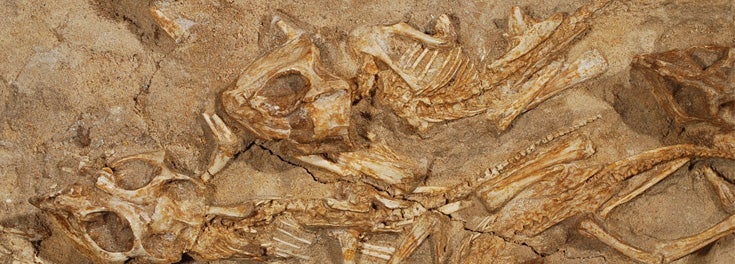
URI has its very own dinosaur hunter, and we call him Professor David Fastovsky. In fact, he’s so widely known for his research on the extinction of dinosaurs that his wax likeness lives immortally in the Milwaukee Public Museum as part of a diorama explaining the clay layer of Earth that marks the boundary between two different geological periods.
The geological sciences have never been more central to the fundamental problems of the world, from clean water shortages, climate change and soil depletion to storm remediation and changing land uses. And URI’s approach to geosciences reflects this in the way we teach.
More recently, though, he’s better known for discovering and leading the study of a 70-million-year-old nest containing the fossilized remains of 15 Protoceratops andrewsi dinosaurs in Mongolia. The bowl-shaped nest measured 2.3 feet in diameter and all 15 dinosaurs it contained were about six inches tall and less than a year old. It’s the first nest of this genus ever found, and the first time we have evidence that Protoceratops juveniles remained in the nest for an extended period. Geosciences professor Fastovsky suspects the juveniles died during a desert sandstorm, and that initial and present-day dryness led to the superb preservation of the fossils.
News of his discovery and findings from his study were reported hundreds of times worldwide in such publications as Smithsonian, National Geographic and Discovery News, and has appeared in numerous languages on websites in Spain, Peru, Chile, Mexico, Poland, Kyrgyzstan, Croatia, Italy, India, Eduador, and many more countries.
But paleontology isn’t the only area of the geosciences that you’ll find at URI. We have leading experts on underwater volcanoes at the Graduate School of Oceanography, as well as award-winning faculty studying earthquakes and the evolution of Earth. Assistant Professor Brian Savage has even developed a seismic model to monitor for nuclear explosions in the Middle East.
And Professor Tom Boving is using his knowledge of hydrogeology, with funding from the World Bank and the Bill and Melinda Gates Foundation, to find drinking water sources in poor areas of India, Jordan and other nations. “What is really needed in many, many places in the developing world is new sources of clean drinking water,” he said. “Clean water has to be cheap, and it has to be easy for the people to access, or it won’t work. We aim to provide the people in our study areas with exactly that.”
The geological sciences have never been more central to the fundamental problems of the world, from clean water shortages, climate change and soil depletion to storm remediation and changing land uses. And URI’s approach to geosciences reflects this in the way we teach, with opportunities for students to get hands-on experience in numerous locations around the country and help make discoveries that can change lives.
It may be the only academic discipline where it’s fun to be between a rock and a hard place.
Photo credit: Dr. Kh. Tsogtbaatar, Director of the Mongolian Paleontological Center, Ulan Baatar, Mongolia
Related Links:
Journal of Paleontology article: A nest of protoceratops
Science Illustrated article: Nest of juvenile dinosaurs discovered
SciTechDaily article: Nest of Juvenile Protoceraops Andrewsi Dinosaurs Discovered
